-
Countries
-
Data and Analysis
-
Special Focus
-
Crisis Responses
Contact
DTM Yemen, iomyemendtm@iom.int
Location
Yemen
Activity
- Mobility Tracking
- Event Tracking
Period Covered
Apr 01 2023 -Jun 30 2023
From 1 January to 30 June 2023, IOM Yemen DTM tracked 3,511 households (HH) (21,066 Individuals) who experienced displacement at least once.
Between 1 April and 30 June 2023, IOM Yemen DTM tracked 1,016 households (6,096 individuals) displaced at least once. The majority of people moved into/within the following governorates and districts:
- Marib (500 HHs) – Harib (309 HHs), Marib City (149 HHs), Marib (41 HHs) districts. Most displacements in the governorate originated from Marib and Al Hodeidah.
- Taiz (266 HHs) – Al Makha (101 HHs), Sabir Al Mawadim (45 HHs), Maqbanah (28 HHs) districts. Most displacements in the governorate originated from Taiz and Al Hodeidah.
- Al Hodeidah (165 HHs) – Hays (96 HHs), Al Khukhah (65 HHs), At Tuhayta (4 HHs) districts. Most displacements in the governorate originated from Al Hodeidah and Taiz.
- Marib (353 HHs) – Harib (336 HHs), Al Jubah (6 HHs), Marib (3 HHs) districts.
- Taiz (268 HHs) – Maqbanah (185 HHs), At Taiziyah (24 HHs), Al Mudhaffar (12 HHs) districts.
- Al Hodeidah (181 HHs) – At Tuhayta (45 HHs), Hays (45 HHs), Jabal Ras (21 HHs) districts.
-
The majority of people moved from the following governorates and districts:
Population Groups
Survey Methodology
Unit of Analysis Or Observation
Type of Survey or Assessment
Keywords
Geographical Scope
Administrative boundaries with available data
The current dataset covers the following administrative boundaries

Contact
DTMUkraine@iom.int
Language
English
Location
Ukraine
Period Covered
May 11 2023
Jun 14 2023
Activity
- Survey
To support partners in providing targeted and evidence-based assistance to the most vulnerable among those who have returned to their areas of habitual residence after a period of forced displacement, the Data and Analytics team of IOM Ukraine is pleased to present the Ukraine Returns Report (Round 13). Starting from June 2023, IOM has transitioned to quarterly implementation of the General Population Survey, providing representative data at the oblast level. The survey was conducted in two phases from 11 May to 14 June 2023. Round 13 offers valuable information on demographics, return dynamics, and intentions of those who have been displaced within Ukraine and abroad (with integrated data and analysis from the IOM Regional Office in Vienna). It also provides detailed insights into household income, employment status, and living conditions of the returnee population. Additionally, it brings previously unavailable data on return as a durable solution in Ukraine, assessing the returnees’ situation along the Inter-Agency Standing Committee (IASC) Durable Solutions criteria, along with elements of social cohesion among the different population groups. The aim is to support evidence-based decision-making on strategic, technical, and programmatic aspects of response and recovery efforts in Ukraine, including the Government of Ukraine. For the purposes of this report, the terms "return” and "returnee” are used without prejudice to status and refer to all persons de-facto in their place of habitual residence after a significant period of displacement (minimum of two weeks since February 2022), regardless of whether they returned to these locations spontaneously from abroad or from displacement within Ukraine. This definition excludes those who have come back to Ukraine from abroad but who have not returned to their places of habitual residence in country.

Contact
DTM Chad, dtmtchad@iom.int
Language
French
Location
Chad
Period Covered
May 02 2023
May 31 2023
Activity
- Mobility Tracking
- Event Tracking
Le suivi des urgences a pour but de recueillir des informations sur les mouvements importants et soudains, ainsi que sur des urgences sécuritaires et climatiques. Les informations sont collectées par le biais d’entretiens avec des informateurs clés ou par des observations directes. Ce tableau de bord présente les informations sur les mouvements de personnes survenus dans la période du 02 au 31 mai 2023 dans la province du Lac.
Depuis le début de l’année 2023, plusieurs incidents ont été observés dans la province du Lac occasionnant un grand nombre de déplacements. Durant le mois de mai 2023, un total de 1 309 ménages (7 290 individus) ont été affectés par des déplacements. Il est à souligner que la majorité de ces personnes (63%) étaient membres des communautés locales avant leur déplacement. Ainsi, les causes des déplacements ont été des mouvements préventifs (51%), des attaques armées (42%) et des enlèvements des personnes (7%). La plupart des déplacements se sont produits à l’intérieur des mêmes sous-préfectures. En effet, 73 pour cent des personnes déplacées se sont réfugiées dans des localités situées dans les mêmes sous-préfectures que leurs lieux de provenance (voir le tableau 1). Les besoins prioritaires généralement rapportés ont été la nourriture (33%), l’eau (33%), les abris (17%) et les articles non-alimentaires (17%).
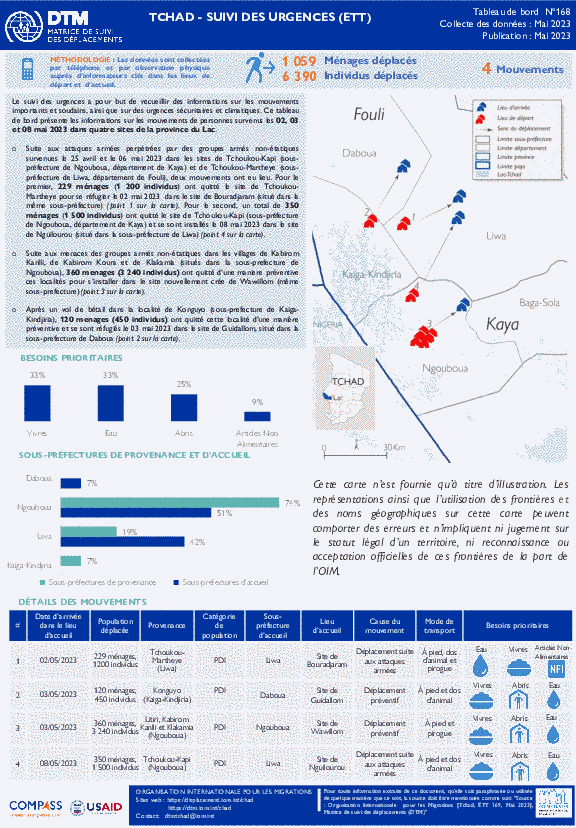
Contact
DTM Chad, dtmtchad@iom.int
Language
French
Location
Chad
Period Covered
May 02 2023
May 08 2023
Activity
- Mobility Tracking
- Event Tracking
Le suivi des urgences a pour but de recueillir des informations sur les mouvements importants et soudains, ainsi que sur des urgences sécuritaires et climatiques. Ce tableau de bord présente les informations sur les mouvements de personnes survenus les 02, 03 et 08 mai 2023 dans quatre sites de la province du Lac.
oSuite aux attaques armées perpétrées par des groupes armés non-étatiques survenues le 25 avril et le 06 mai 2023 dans les sites de Tchoukou-Kapi (sous-préfecture de Ngouboua, département de Kaya) et de Tchoukou-Martheye (sous-préfecture de Liwa, département de Fouli), deux mouvements ont eu lieu. Pour le premier, 229 ménages (1 200 individus) ont quitté le site de Tchoukou-Martheye pour se réfugier le 02 mai 2023 dans le site de Bouradjaram (situé dans la même sous-préfecture) (point 1 sur la carte). Pour le second, un total de 350 ménages (1 500 individus) ont quitté le site de Tchoukou-Kapi (sous-préfecture de Ngouboua, département de Kaya) et se sont installés le 08 mai 2023 dans le site de Nguilourou (situé dans la sous-préfecture de Liwa) (point 4 sur la carte).
oSuite aux menaces des groupes armés non-étatiques dans les villages de Kabirom Kanlli, de Kabirom Koura et de Klakamia (situés dans la sous-prefecture de Ngouboua), 360 menages (3 240 individus) ont quitté d’une maniere préventive ces localités pour s’installer dans le site nouvellement crée de Wawillom (même sous-prefecture) (point 3 sur la carte).
oAprès un vol de bétail dans la localité de Konguyo (sous-prefecture de Kaiga-Kindjiria), 120 menages (450 individus) ont quitté cette localité d’une manière préventive et se sont réfugiés le 03 mai 2023 dans le site de Guidallom, situé dans la sous-prefecture de Daboua (point 2 sur la carte).
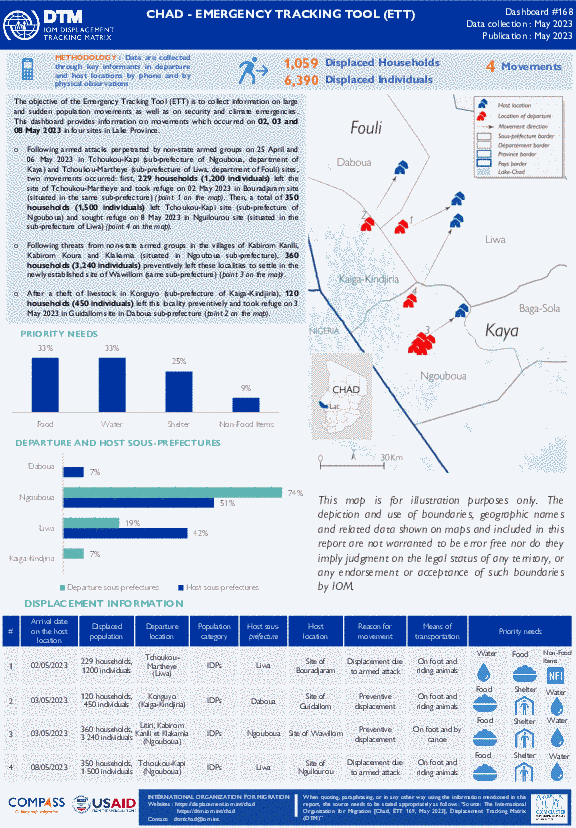
Contact
DTM Chad, dtmtchad@iom.int
Language
English
Location
Chad
Period Covered
May 02 2023
May 08 2023
Activity
- Mobility Tracking
- Event Tracking
The objective of the Emergency Tracking Tool (ETT) is to collect information on large and sudden population movements as well as on security and climate emergencies. This dashboard provides information on movements which occurred on 02, 03 and 08 May 2023 in four sites in Lake Province.
oFollowing armed attacks perpetrated by non-state armed groups on 25 April and 06 May 2023 in Tchoukou-Kapi (sub-prefecture of Ngouboua, department of Kaya) and Tchoukou-Martheye (sub-prefecture of Liwa, department of Fouli) sites, two movements occurred: first, 229 households (1,200 individuals) left the site of Tchoukou-Martheye and took refuge on 02 May 2023 in Bouradjaram site (situated in the same sub-prefecture) (point 1 on the map). Then, a total of 350 households (1,500 individuals) left Tchoukou-Kapi site (sub-prefecture of Ngouboua) and sought refuge on 8 May 2023 in Nguilourou site (situated in the sub-prefecture of Liwa) (point 4 on the map).
oFollowing threats from non-state armed groups in the villages of Kabirom Kanlli, Kabirom Koura and Klakamia (situated in Ngouboua sub-prefecture), 360 households (3,240 individuals) preventively left these localities to settle in the newly established site of Wawillom (same sub-prefecture) (point 3 on the map).
oAfter a theft of livestock in Konguyo (sub-prefecture of Kaiga-Kindjiria), 120 households (450 individuals) left this locality preventively and took refuge on 3 May 2023 in Guidallom site in Daboua sub-prefecture (point 2 on the map).
Contact
DTM Sudan, DTMSudan@iom.int
Location
Sudan
Activity
- Mobility Tracking
- Baseline Assessment
Period Covered
May 19 2023 -Jul 16 2023
The current total estimate of recently displaced individuals across Sudan has reached 2,613,036 Individuals (523,142 Households). The current assessment has observed the IDP caseload in all of Sudan’s 18 states. The highest proportions of IDPs have been observed in River Nile (16.38%), Northern (13.73%), White Nile (10.25%), and Sennar (8.08%) states. Field teams report that the IDPs observed were originally displaced from eight states. The majority (73.13%) have been reportedly displaced from Khartoum state; followed by West Darfur (8.01%), North Darfur (7.26%), South Darfur (6.34%), Central Darfur (4.58%), North Kordofan (0.37%), South Kordofan (0.30%), and Aj Jazirah (0.01%).
Population Groups
Survey Methodology
Unit of Analysis Or Observation
Type of Survey or Assessment
Keywords
Geographical Scope
Administrative boundaries with available data
The current dataset covers the following administrative boundaries
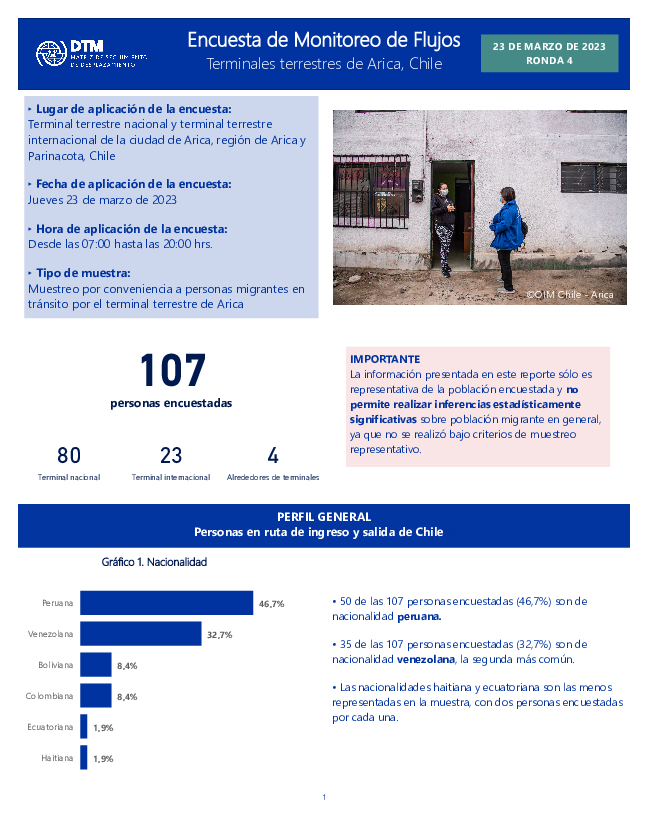
Contact
iomdtmchile@iom.int
Language
English
Location
Chile
Period Covered
Mar 23 2023
Mar 23 2023
Activity
- Survey
Según las últimas estimaciones publicadas por el Instituto Nacional de Estadística (INE) y el Servicio Nacional de Migraciones (SERMIG), un aproximado de 444 mil personas venezolanas se encontraban en Chile hasta diciembre de 2021, lo que mantiene a Chile como uno de los países con mayor cantidad de población venezolana en el mundo.
En ese sentido, la OIM Chile, como parte de su estrategia de producción de información al servicio los y las tomadores de decisión, ha implementado la DTM Encuestas de Monitoreo de Flujos en la región de Arica y Parinacota con el objetivo de identificar el perfil de las personas que ingresan por esta frontera, caracterizar sus experiencias en ruta, consultar respecto a la documentación con la que viajan y conocer sus intenciones futuras.
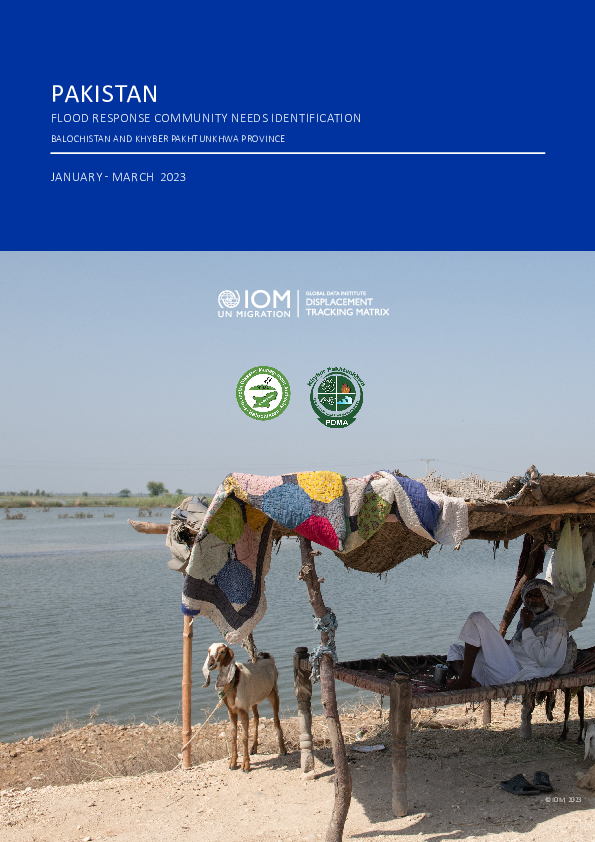
Contact
dtmpakistan@iom.int
Language
English
Location
Pakistan
Period Covered
Jan 06 2023
Mar 28 2023
Activity
- Survey
- Mobility Tracking
- Site Assessment
From June to October 2022, storms and heavy monsoon rains in Pakistan have caused widespread flooding and landslides across the country. According to the National Disaster Management Authority (NDMA), up to 33 million people have been affected by the floods and a total of 90 districts have been labelled by the Government of Pakistan as ‘calamity-hit’, as of 18 November 2022. Given the number of calamity-hit districts and the number of affected people, IOM's Displacement Tracking Matrix (DTM) decided to roll out its Community Needs Identification (CNI) assessment. This was done following coordination and approval from the Provincial Disaster Management Authority (PDMA) of Balochistan and Khyber Pakhtunkhwa. Following the first round of the CNI, IOM implemented a second round of the CNI between January and March 2023 to provide partners with timely information on the displacement situation and multisectoral needs of the affected population at the village level.2 For the second round, IOM expanded its CNI from 13 to 19 districts in the provinces of Balochistan and Khyber Pakhtunkhwa. The CNI was conducted in a total of 6,367 flood affected villages or villages that hosted temporary displaced persons (TDPs) across the 19 targeted districts.
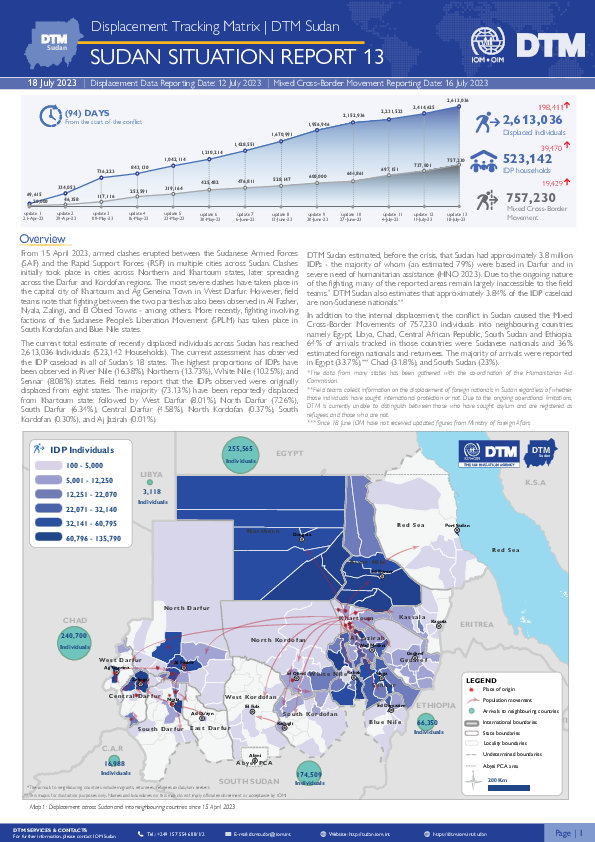
Contact
DTM Sudan; dtmsudan@iom.int
Language
English
Location
Sudan
Period Covered
Jul 12 2023
Jul 12 2023
Activity
- Mobility Tracking
- Baseline Assessment
From 15 April 2023, armed clashes erupted between the Sudanese Armed Forces (SAF) and the Rapid Support Forces (RSF) in multiple cities across Sudan, including Khartoum, Al Fasher, Kebkabiya, Merowe, Nyala, Zalingi, Ag Geneina, and El Obeid. DTM Sudan has been receiving reports of widespread displacement across different states in Sudan due to the ongoing security situation.
- DTM Sudan estimates that, since 15 April 2023, approximately 2,613,036 individuals (523,142 households) have been displaced internally as a result of the conflict. Notably, the current estimate for displacement in the previous 94 days is greater than that of recorded displacement during the previous four years.
- Furthermore, an estimated additional 757,230 individuals have crossed into neighbouring countries.
Due to the ongoing nature of the fighting, many areas reportedly remain inaccessible to field teams. DTM estimates of displacement are based on preliminary reports from field teams and should be taken as estimations only. Additional reports of displacement are likely to emerge as the situation becomes clearer.
The IDP caseload has sought shelter in locations across all of Sudan’s 18 states. IDPs have been originally displaced from eight states, including Khartoum, West Darfur, South Darfur, North Darfur, Central Darfur, North Kordofan, South Kordofan, and Aj Jazirah.
Disclaimer: DTM Sudan notes that military clashes remain continuous in many areas across Sudan in particular in Khartoum and the Darfur region – limiting humanitarian access. Additionally, field teams have reported severe telecommunication and connectivity issues, as well as escalating economic pressures which have impacted the capacity for domestic travel. As such, DTM is currently conducting remote interviews with key informants across its network and is currently unable to engage in the additional verification of these figures. Data on flows into neighbouring countries is based on available information from DTM flow monitoring networks and secondary sources.